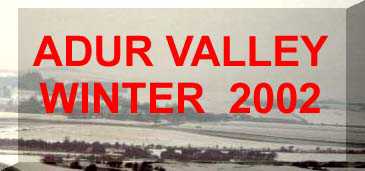| WILDLIFE REPORTS
31
March 2003
A Cuckoo
was seen amongst the Cokeham
Reed Beds, west Lancing. (TQ 167 043).
NB:
This is an exceptionally early record, possibly a month before the usual
first sighting of this immigrant.
30
March 2003
An
Osprey flew in quite low off the sea,
this was just east of Widewater, it circled
round and round gaining height over the sea and beach, then circled over
towards the Adur estuary where what I think was a Sparrowhawk
sparred briefly with it, the Osprey
then came back towards me circling higher and higher, before embarking
on one of those flapless, effortless glides on slightly angled wings NNE
into the wind, it gave only two flaps before it vanished as a speck in
the distance inland, in all I guess I watched it for around 15 minutes
- absolutely splendid!
A
sunny spring day with a handful of Small
White and Small
Tortoiseshell Butterflies were in flight
over Buckingham Park, Shoreham.
28
March 2003
A Short
Eared Owl was seen twice in the early
evening over New Monks Farm, Lancing.
27
March 2003
I
spotted by first white butterfly of the year, probably a Small
White Butterfly over the Hamm Road allotments
(Eastern Avenue) Shoreham.
Adur
Butterflies
24
March 2003
It
seemed as though the Little Egret
flying over the Old Fort was following a small fishing boat up the River
Adur. Was it same one feeding in the stream next to the towpath by
Shoreham Airport? Spring seems to have finally
arrived. It looked like a couple of Swallows
diving rather low over the same unappealing stream. There was a local buff
coloured Meadow Pipit
with its dipping flight over the Sea Purslane
at low tide.
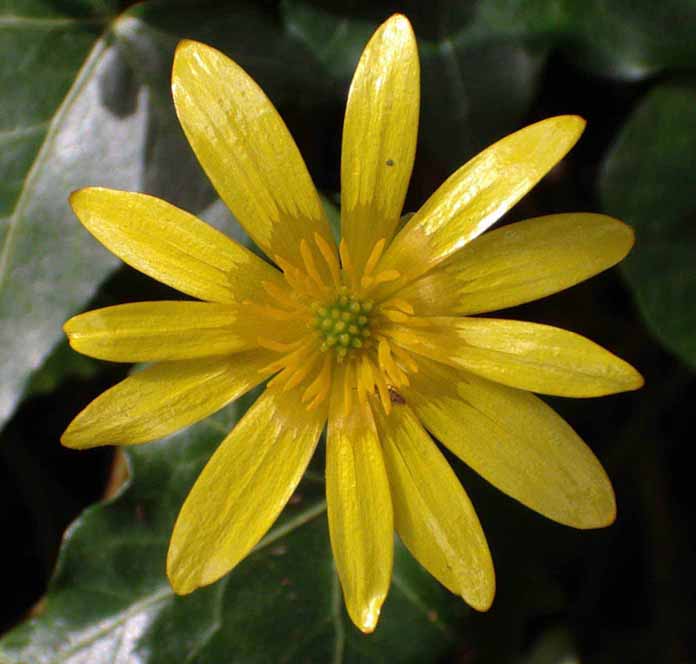 Scores
of Small Tortoiseshell Butterflies and
Buff-tailed
Bumblebees were around the fringes of
Shoreham
town and on the Coombes road and
a single Peacock Butterfly
settled on the cycle path by the Cement
Works. The yellow flowers by the roadside were Lesser
Celandine. There were hundreds of sheep
and
newly born lambs (with blue tags in
their ears) in the fields adjoining the road
especially near Church Farm, Coombes. Scores
of Small Tortoiseshell Butterflies and
Buff-tailed
Bumblebees were around the fringes of
Shoreham
town and on the Coombes road and
a single Peacock Butterfly
settled on the cycle path by the Cement
Works. The yellow flowers by the roadside were Lesser
Celandine. There were hundreds of sheep
and
newly born lambs (with blue tags in
their ears) in the fields adjoining the road
especially near Church Farm, Coombes.
Vernal
Equinox
Bumble
Bee Page
23
March 2003
A
Comma
Butterfly was in in my south Lancing garden
pond (TQ 186
044) nectaring on Viburnum x bodnantense.
This is the earliest in the year that I have seen this species of butterfly.
Butterflies
of Lancing
20
March 2003
A
Brimstone
Butterfly was seen near to Lancing Manor
Allotments at the foot of McIntyres field.
19
March 2003
A
steady stream of orange-tailed bumblebees
were
observed flying eastwards over the shingle beach to the seaward edge of
Widewater Lagoon. Over a period of two hours, a bee must have passed every
30 seconds and I estimated the total numbers passing at about 136. Later
in the afternoon a smaller fly-pass occurred.
NB: The
species was probably the Red-tailed (Jewel)
Bumblebee,
Bombus
lapidarius.
Shoreham
Beach page
Frog
tadpoles (pic)
hatch out in my south Lancing garden pond (TQ
186 044) and a pair of Magpies,
from the Hawthorn
tree, pinched the turf from the pond's edge.

Clingfish
on bryozoans
The
clingfish is about 10 mm long
 The
low equinoctial
spring
tide
receded as far as I have known it uncovering all the rocks on Lancing
Beach. It was too dark to explore the exposed shore properly, but juvenile
Small-headed
Clingfishes (probable ident.) were
present under rocks, with hundreds
of crabs and a chiton,
a
full sized Acanthochitona crinita.
The chiton is 29 mm long and 20 mm at its widest part. The sea anemone
Sagartia
troglodytes was common and the Snakelocks
Anemone frequently seen. The
low equinoctial
spring
tide
receded as far as I have known it uncovering all the rocks on Lancing
Beach. It was too dark to explore the exposed shore properly, but juvenile
Small-headed
Clingfishes (probable ident.) were
present under rocks, with hundreds
of crabs and a chiton,
a
full sized Acanthochitona crinita.
The chiton is 29 mm long and 20 mm at its widest part. The sea anemone
Sagartia
troglodytes was common and the Snakelocks
Anemone frequently seen.
Species
List
BMLSS
Chiton page
BMLSS
Molluscs
There
were two pairs of Shelducks at
the eastern end of Widewater
Lagoon.
 The
bumblebee on the railway path near the Toll
Bridge, Old Shoreham, was striped
orange and black.
This was a queen (the orange pollen basket
indicates) of the Buff-tailed
Bumblebee, Bombus
terrestris, which is the commonest
species locally. The white (not buff) tail is usually very clear with this
species: its most distinguishing feature. (The White-tailed
Bumblebee, Bombus locurum is similar
but smaller with a lemony coloured band.) The
bumblebee on the railway path near the Toll
Bridge, Old Shoreham, was striped
orange and black.
This was a queen (the orange pollen basket
indicates) of the Buff-tailed
Bumblebee, Bombus
terrestris, which is the commonest
species locally. The white (not buff) tail is usually very clear with this
species: its most distinguishing feature. (The White-tailed
Bumblebee, Bombus locurum is similar
but smaller with a lemony coloured band.)
The
chirrupy calls of the Robin Redbreast were
noticeable north of the Toll Bridge, and a particularly colourful Chaffinch
singing from a tree on the short path from Botolphs to the River
Adur (just to the north of the South Downs
Way bridge). To the north of the path it appears to be recently (2001?)
neglected or set-aside land, notably better in wildlife than the adjacent
arable lands. Small Tortoiseshell Butterflies
were
seen near shelter in the valley, but only about six of these butterflies
were flying strongly and not settling.
A
Little
Egret was the only bird in the first flood
plain field north of the Toll Bridge (field artificially seeded for cattle).
This field tends to be damp with deep drainage streams around the edge.
Adur
Levels
17
March 2003
For
the first time ever I discovered six 15 cm long Sand Smelt, Atherina
presbyter, in my shrimp push-net off Southwick beach, together with
three pints of Brown
Shrimps and some orange crabs (species
not identified), plus a couple of small Weevers.
The Sand Smelt is a silvery fish found in the River Adur estuary
in summer.
Report
by Peter Talbot-Elsden
Shorewatch
Project
My
first butterfly of the year was a Small
Tortoiseshell flying strongly over Gordon
Road, Shoreham town centre, on a sunny hazy day.
Of the birds calling during the day, the Collared
Doves, Herring
Gulls and Song
Thrush were
the loudest and most strident, joined by the melody of the Blue
Tit on the lower slopes of Mill Hill,
south of the by-pass.

It was
is in this area that a group of three Small
Tortoiseshell Butterflies, were seen and photographed
and another three on Mill Hill near the reservoir.
The shade air temperature reached 13°
C.
 A
Red-tailed (Jewel) Bumblebee,
Bombus
lapidarius, crawled out of the long grass just south of the reservoir
on Mill Hill. There was a
small
orange mite
on its abdomen. This species of bumblebee is the second commonest locally
throughout the year. A
Red-tailed (Jewel) Bumblebee,
Bombus
lapidarius, crawled out of the long grass just south of the reservoir
on Mill Hill. There was a
small
orange mite
on its abdomen. This species of bumblebee is the second commonest locally
throughout the year.
I
am tempted to say that the mite is a deutonymph
of Parasitellus.
Bumble
Bees
Social
Bees
Parasites
on Bumblebees
Classification
of Acari
Six
Common Species of Bumblebees (UK)
World
List of Bumblebees (NHM)
Predators
and symbionts of Bumblebees
16
March 2003
As
the sun set and full moon illuminated the early evening, there was an astonishing
amount of bird song in the scrubs from Withy Patch with birds communicating
over four lanes of the A27, and various bird calls were heard continuously
all the way down the path south of Toll
Bridge in the bushes by the old railway track, and again in the scrub
and small trees by the railway main line at the southern end of Raven's
Road, Shoreham. It appeared that most of the singing came from Blackbirds
and other thrushes.
On
beach near the Brooklands outfall pipe, three Turnstones
could
be approached quite closely before they flew off calling. Twenty Sanderlings
pattered
over the sand surface and there was a few Ringed
Plover as well. Alas the low tide
of 1.06 metres
did not uncover as many rocks as known before, and the intertidal fauna
was exiguous, limited to a few common species including the Hairy
Crab and small sea anemones Sagartia
troglodytes, Beadlet
Anemone and a single Snakelocks
Anemone. There were numerous Dogwhelks
on the mussel beds on the Brooklands pipe.
BMLSS
Rockpooling Page
A flock
of about a dozen Jackdaws
perched on the Beech
trees in The Drive (near Buckingham Park), Shoreham-by-Sea,
(TQ
219 063).
15
March 2003
One
Red Admiral Butterfly, very large and
perfect, was hovering in the sun and five Small
Tortoiseshell Butterflies were seen in
my Lancing garden.
Adur
Butterflies
14
March 2003
The
first Small Tortoiseshell Butterfly
of the year visited my south Lancing garden in the sunshine with a gentle
north-east breeze. (TQ 186 044).
British
Butterflies Flight Times
On
the mud flats south of Old Shoreham Toll
Bridge the low spring tide had receded a low
way so in the fading light it was difficult to identify some of the wading
birds through my low powered (10 x 25) binoculars. There were fifteen medium-sized
wading birds in the shallows on the water's edge. At least three were Redshanks
as
the red colour of their legs discerned as they trotted quickly over the
mud itself, but the other waders appeared to be a different species, with
black legs and bill and a dark head (possibly Godwits?). They were very
active wading in water up to their knees, probing very deeply into the
mud. They were probably all Redshanks, but it is unusual to see them on
Adur in small flocks - they are usual single, with perhaps a couple more
in close proximity. Much easier to recognise, were a pair of Shelducks,
just a solitary Dunlin,
three Mute Swans,
a couple of feeding Little Egrets
and a couple of Great Black-backed Gulls.
A
flock of about a dozen Jackdaws
foraged around the green mown grass of the Holmbush roundabout, north-east
Shoreham.
8 March
2003
There
were five ducks up-ending themselves to feed in Widewater
Lagoon (eastern end). Some 25% smaller than Mallards,
I have penned these in as Teals.
One of them was chased by an aggressive Black-headed
Gull.
6 March
2003
After
a month of very little rainfall, I would guess that the salinity would
rise slightly in Widewater Lagoon,
which was heavily in flood which is usually associated with heavy rainfall.
The
SG
was measured and the salinity calculated at 27‰. However,
after deducting the hydrometer correction figure we arrive a salinity of
22‰ (ppt). This reading represents the largest
monthly rise in salinity for a whole year.
5 March
2003
A
pair of Mandarin
Ducks were seen on Brooklands Boating
Lake this evening. This is a "naturalised" alien species from the Far East
(China and Japan) has escaped from captivity and breeds in south-east England.
At
3:30 pm a single Swallow
flew up the Adur then low across the Shoreham
Airport heading north west. A real early bird?
4
March 2003
A
Goldcrest
was in in my south Lancing garden in the rain, again. (TQ
186 044). This was a bright spark on a murky
overcast grey day.
2
March 2003
An
escaped Eagle with jesses
was seen over Cokeham Reed Beds, Sompting. It was mobbed by crows
and seen heading for the downs. This bird was
not a Harris
Hawk identified from Cissbury later in
the month.
Lost
& Found "Birds of Prey"
A
Common
Shrew,
Sorex araneus, was discovered
under the forcing cover of the
rhubarb
plants on our Lancing Manor allotment.
Shrew
Page
A
Great
Tit was calling loudly and persistently
from a tree in the south-western corner of Buckingham Park, Shoreham. The
firstFrog
spawn is laid amongst the few sticks of
weeds in the back garden of 40 The Drive (near Buckingham Park), Shoreham-by-Sea,
(TQ
219 063) some 16 days later than the spawn
was laid in Lancing, and 26 days after the first frogs were seen in
the pond.
1 March
2003
Five
Purple
Sandpipers as well as about five Turnstones
were on the central wooden pier near the Old Fort, Shoreham Beach. (TQ
234 045)
Small
Butterfish
could be found under the rocks in the piddock
chalk area at mid-tide level on
Kingston beach.

26 February
2003
In
the fading light a couple of Shelducks
waddled in the mud just south of the Toll
Bridge.

It
was a surprise to see a black Brent Goose
wading
around the edges and swimming on the surface of Widewater
Lagoon.
 25
February 2003 25
February 2003
A
Dunnock
(Hedge Sparrow) was spotted foraging on
fallen sunflower seeds underneath the bird table in my south Lancing
garden (TQ 186 044).
21
February 2003
On
a half spring tide near the Toll Bridge
there was one actively feeding Bar-tailed
Godwit, on the edge and shallow water,
dipping its long beak repeatedly in the mud, with a small flock of Dunlins
and a handful of stationary Grey Plovers.
19
February 2003
Withy
Patch stroud (TQ 193 057)
Nothing
until I started pushing, then two Blue
Tits, two Great
Tits, four Long-tailed
Tits, a Goldcrest
and a couple of Robins
hopped out. Also a distant Great Spotted
Woodpecker calling but
unfortunately no Willow Tit, and
no Barn Owl which
I had seen there before.
Previous
Report from Withy Patch
 18
February 2003 18
February 2003
At
least 30 Pochards
swam on Brooklands Boating lake in the middle of the afternoon.
17
February 2003
Two
Shelducks
with bright red beaks
followed by a Ruddy Shelduck
ventured close in to the shore on a high spring tide just south of the
Old Shoreham Toll Bridge
and swam around poking their heads under water, presumably to tug at the
vegetation to eat.
Adur
Estuary
In
the drainage ditches surrounding the sheep fields on the Adur
levels by the Waterworks (north of Old Shoreham) the water was covered
by ice at a thickness of 20 mm at midday. It was not clear if the frogs
had laid their spawn yet. The deeper slow running stream was clear of ice.
At
2:30
pm the dew point was minus 7.4°C, the
humidity down to 40% but the air temperature which had been above
freezing for most of the day had risen to 5.4°C in a light breeze (Force
2) that chilled at 3.2°C.
Beaufort
Scale
12
February 2003
On
a misty drizzly day the Ruddy Shelduck
sheltered in the lee of the island on Brookland's Boating Lake, with over
fifty Coots,
a couple of Moorhensand
a small flock of about a dozen Pochards
which could be seen reasonably close up (with 10 x 25 binoculars) with
their attractive maroon head (male only).
In
the stroud
by the weighbridge just to the west of Withy Patch, Lancing, (TQ
193 057) I heard the call of the Willow
Tit, the call repeated four times in one
burst, distinctly, despite the hum of the traffic as dusk approached, before
all the other hidden birds burst into song.
Call
of the Willow Tit (second call heard)
Great
Tit call (can sound a bit like that of the Willow Tit)
Previous
Report
Just
north of the Old Shoreham Toll Bridge, every
30 metres or so there was a Chaffinch,
in the hedgerow next to the horse field, a frequently seen bird, but not
as readily noticeable when there is greenery on the bushes.
After
the mist cleared there were a pair of Peregrine
Falcons circling over the Shoreham Harbour
Power Station chimney, one falcon going into the large nest box on the
southern side and the other bird right on top of the chimney.
Report
by Peter Talbot-Elsden
Breeding
Report
There
was a ripple of activity on the pond in my back garden, in south Lancing
(TQ
186 044) as I checked on it this morning.
A pair of mating
Frogs
are resting on the surface among the weed near the edge of pond. They are
tending a freshly produced clump of spawn.
The
pond and spawn froze over at night.
10
February 2003
As
the tide rolled in covering up the sand on the beach immediately south
of Widewater Lagoon a small flock of Sanderlings
flew
around and settled on the fine shingle nearer the sea's edge and a Turnstone
wandered over the rock sea defences, its red
legs and white under tail feathers particularly
clear. Over the grass adjacent to the lagoon itself, a large brown Kestrel
hovered.
Report
by June Brown
9
February 2003

A Mayfly larva from
my garden pond at x 60 magnification
Discovered
by Katherine Hamblett
Image
by Ray Hamblett
(Lancing Nature)
7 February
2003
A
couple of Purple Sandpipers
were on the Inner East Pier (by the Old Fort) of Shoreham Harbour, a couple
of hours before high water.
6
February 2003
A
pair of Long-tailed Tits
descended from the eight metre Hawthorn
Tree at the bottom of my south Lancing
garden (TQ 186 044) to
feed on peanuts at the feeder.
2
February 2003
A
Great
Tit with a posse of Blue
Tits was another first for the back garden
of 40 The Drive (near Buckingham Park), Shoreham-by-Sea, (TQ
219 063).
Three Common
Frogs were in the pond, but no spawn had
been laid.
A
flock of 20+ Jackdaws rose
from the tall Beech trees in the same road.

30 January
2003
In
the town there was a flurry of snow. On the downs
there was a light covering which disappeared by the following day.

The
Dewpond at Lancing Clump
Photograph
by Ray
Hamblett (Lancing Nature)
29
January 2003
A
Bullfinch
visited my Shermanbury
garden this morning.
Upper
Adur East (Shermanbury area) Nature Pages
27
January 2003
The
sun came out today and there was a Small
Tortoiseshell Butterfly in my Shermanbury
garden.
Shermanbury
Footpaths
Midday:
It was a low neap tide at 1.6
metres on the Adur
between the Toll Bridge and the Railway
Viaduct with over a thousand Black-headed
Gulls, nearly a thousand Lapwings,
over a hundred Dunlins,
an uncounted number of Ringed Plovers,
a handful of Great Black-backed Gulls,
at least three Cormorants
fanning their wings on the mud banks, the inevitable Mute
Swans, an occasional feeding Redshank,
and just a solitary actively feeding Bar-tailed
Godwit, in the shallow water, dipping
its long beak repeatedly in the mud, the raised slightly upcurved beak
slightly agape. This bird selection is usual perhaps even slightly disappointing
for the first two months of the year. Crows
were amongst the mud and rocks and even House
Sparrows were feeding amongst the Sea
Purslane.
3:30
pm: The river still looked very low although
the tide measurement at the harbour entrance was now 3 metres. A Grey
Heron had arrived and stood like a stature
at the end of the sand spit with 30 newly arrived Great
Black-backed Gulls, plus some Herring Gulls.
The Godwit and
most of the Lapwings
had departed, but amongst the hundred plus Dunlins,
exactly a dozen Grey Plovers
stood out looking like dumpy oversized Dunlins
with short beaks and black legs.
26
January 2003
A
lovely male Red Breasted Merganser
was on the small island at the eastern end of the Widewater
Lagoon from 2.45 pm until 3.15 pm
when I left.
A
Bar-tailed
Godwit was spotted just south of the Old
Shoreham Toll Bridge, the first time I have seen this wader here. This
confirmed my earlier report. Also
a very lonely-looking Brent Goose
was around!
24
January 2003
Birds
have been discovered washed up oiled but still alive on the beaches between
Southwick and Worthing, mostly Guillemots,
but at least one Razorbill
was discovered in a distressed condition. The source of the oil is not
known, but these oiled birds are reported every year and some are treated
by the Worthing & District Animal Rescue
Service (WADARS).
23
January 2003
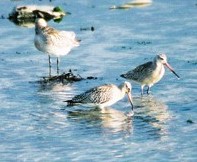 At
high tide, there was just a small patch of mud covered in greenery (Glasswort
and algae) south of the Toll Bridge
(TQ 207 058), occupied by about 150
Lapwings
and one other mottled
grey and white wader with a long almost straight beak and a glimpse of
black tail feathers. The Lapwings were disturbed but this bird remained
unperturbed. Occasionally, it tucked its beak into his chest so the beak
was invisible. I watched it for over ten minutes, long enough for a plump
Ringed
Plover to arrive. Still the wader remained
stationary with just a few struts in shallow water on firm mud on the tideline,
but it did not feed. It was definitely a
Godwit, and I think (90% sure) it was a Bar-tailed
Godwit, Limosa
lapponica, and this was the first time I have noticed (through
binoculars) this easily overlooked wading bird on the estuary.
Black-tailed
Godwits have also been recorded on the Adur. At
high tide, there was just a small patch of mud covered in greenery (Glasswort
and algae) south of the Toll Bridge
(TQ 207 058), occupied by about 150
Lapwings
and one other mottled
grey and white wader with a long almost straight beak and a glimpse of
black tail feathers. The Lapwings were disturbed but this bird remained
unperturbed. Occasionally, it tucked its beak into his chest so the beak
was invisible. I watched it for over ten minutes, long enough for a plump
Ringed
Plover to arrive. Still the wader remained
stationary with just a few struts in shallow water on firm mud on the tideline,
but it did not feed. It was definitely a
Godwit, and I think (90% sure) it was a Bar-tailed
Godwit, Limosa
lapponica, and this was the first time I have noticed (through
binoculars) this easily overlooked wading bird on the estuary.
Black-tailed
Godwits have also been recorded on the Adur.
The Peregrine
Falcon appeared on the north side of the
Shoreham Harbour Power Station chimney (TQ
246 048) at breakfast time (8:00
am) this morning.
Nest
Box Link
Earlier
(2002) Reports
Report
by Peter Talbot-Elsden
21
January 2003
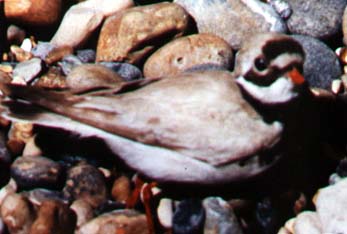 With
due southerly winds up the Gale
Force 7 at times pushing a high spring
tide
(6.2 metres)
against the shingle beach, there was very little foreshore by Brooklands
Boating Lake and the Ringed Plovers
(at least four, probably more) occupied the crest of the shingle bank and
even ventured on to the coastal path. With
due southerly winds up the Gale
Force 7 at times pushing a high spring
tide
(6.2 metres)
against the shingle beach, there was very little foreshore by Brooklands
Boating Lake and the Ringed Plovers
(at least four, probably more) occupied the crest of the shingle bank and
even ventured on to the coastal path.
The
strandline
showed nothing exceptional. A dozen egg purses of the Thornback
Ray (Mermaid's Purses)
were washed up in the space of 25 metres on the Old Fort beach. By Ferry
Road beach, Shoreham, over a dozen Cuttlefish
bones
lay scattered about with the flotsam in the
space of 25 metres. These
are Sepia officinalis as only this one, the commonest of the large
cuttlefish, are found in Sussex seas.
BMLSS
Cuttlefish and Cuttlebones
Coastal
Fringe (Shoreham Beach)
20
January 2003
At
first I thought it was two Wrens
in my back garden, in south Lancing (TQ 186
044): the bird was similar in size to a wren
but moved in a more restless erratic
manner,
the yellow flash on the head showed it as a Goldcrest.
19
January 2003
In
the tiny front garden of 123 Old Shoreham Road, Shoreham (west side, midway
between the Swiss Cottage going north to the Amsterdam, with back gardens
that back on to the old railway track waste land adjacent to the River
Adur) a large healthy looking Red Fox
almost filled the garden with its presence at 3:00
pm on a bright cloudless afternoon. It remained
in-situ long enough for me to get the camera out of its bag, but bounded
off over the low walls separating the gardens and disappeared from view
before I could focus and press the shutter.
18
January 2003
Looking
for Willow Tits
near the Withy Patch (TQ 192 057),
Lancing, alas, there was only a couple of Blue
Tits.
Willow
Tits at Withy Patch 2002
16
January 2003
A
pair of Shelducks
were on the Adur between the Railway Viaduct
and the Toll Bridge.
A
small wren-sized bird flew just like a wren and it looked a bit like a
miniature chaffinch but with a much more colourful head. It was in the
palms and greenery at the sea end of a large garden at the eastern end
(TQ
186 037) of Lancing Beach Green. Alas, the
sighting was very brief, but this was my first ever observation of a Goldcrest,
the smallest British bird. The Goldcrest is reported as being common enough
in Sussex. (The bird looked to me more like a Firecrest,
but this latter bird is 25 times less likely than the former.) This bird
was accompanied by an ordinary Wren.
14
January 2003
As
the low tide rolled in over the sandy flats immediately to the west of
the Brooklands outfall pipe, there was commotion in the shallow sea as
at least one hundred
Cormorants and a similar number of mixed
gulls
all collected in a very small patch of very shallow (less than a metre
deep) rolling sea. 30+
Sanderlings
pattered across the exposed mud, this small bird regularly probing for
food. The Cormorant
count for this area is usually about 30.
12
January 2003
A Waxwing
is spotted in St Mary's churchyard, Shoreham, SW of railway station at
4.10
pm (TQ 216 051).
It was perched in one of the trees (not feeding) before making two short
flights to the western edge of the churchyard and then lost to my view.
This
colourful bird is a truly extraordinary and newsworthy sight. Small irruptions
rarely occur from their northern European wintering grounds. This bird
is a very rare sight in Sussex. It has been recorded on a handful of occasions
in Shoreham in the last 50 years, but the last time was as long ago as
1965.
Waxwing
Web Page
SOS
Waxwing Records
Waxwing
Photographs (not this bird)
A fairly
heavy hoar frost greeted us this morning. "Hoar
frost occurs when water vapour touches a very cold surface and freezes
on it instantly. This can happen to the leaves and branches of plants,
and will cover them with ice crystals that look like spiky fingers."
Clouds
R US Frost Page
An
Oystercatcher
perched on a wooden groyne on Kingston beach.
It was at neap low tide
so the mussel beds and sandy and weed shore below
the shingle would not be uncovered today.

The
fish pond at Ewhurst
Manor, near Shermanbury was
completely frozen over except for one small area.
Upper
Adur East (Shermanbury area) Nature Pages
11
January 2003
A dog
Fox
was seen crossing the Mile Oak Road close to the 6th Form College,
High Street, Portslade Village, at 12.30 pm.
As I drove slowly toward the narrow part of the road before the blind corner
close to the school. I had no other cars behind me and out of the corner
of my eye I saw an animal walk onto the road. I slowed and stopped. To
my astonishment I watched a fully grown Red
Fox leisurely cross the road in front of me,
it climbed a small bank briefly cocking a leg to scent mark the gap in
the hedge of the garden it entered. All this in bright sunshine!
9
January 2003
Black-headed
Gulls were standing on the thin layer
of ice that covered
nearly the whole expanse of Widewater Lagoon,
the Mute Swans
were restricted to a small area of clear water near the houses. The Little
Egret was predictably missing as it would
have had few opportunities to feed in the frozen margins.
The
small pipits on the shingle above high tide mark looked like Meadow
Pipits. The air temperature only crept
above freezing at midday, where 30 Mallards
on the mud flats near the Footbridge,
buried their heads into their feathers.
On
the small area of exposed mudflats (TQ 210
053) just north of the Railway
Viaduct spanning the Adur at Shoreham, a couple of Oystercatchers
were probing continually in the soft mud for food. The usual Lapwings
were present, and I heard the squawky alarm call of the Redshank
twice within 30 metres of riverbank, but it was the hundreds of Dunlins
all over the mud, not just at the water's edge, that were most noticeable.
They were more numerous near the Toll
Bridge.
8 January
2003
A
thin layer of ice formed over the shallow fringes of Widewater
Lagoon.
Widewater
Page (by Ray Hamblett
Engineers
have begun the first stage of the seawater pipe installation at Widewater
Lagoon.
New
Pipeline Installation Notes
5 January
2003
A
male Blackcap
is visiting my garden in Shadwell's Road, Lancing.
The
garden ponds in Shoreham town and gardens are frozen over with a glass-like
(3 mm to 6 mm) layer of ice for the whole of the day. The temperature remained
under
3 ºC for
all hours of daylight.
Shoreham
Beach Weatherflash (Instant Readings) Page
Shoreham
Beach Weather: Detailed Statistics and Daily Page
4 January
2003
Widewater
Lagoon is in flood after the recent rain and the salinity fell to 15‰.
The Little Egret
foraged in the shallows as usual. This bird is not ringed.
Widewater
Salinity Page
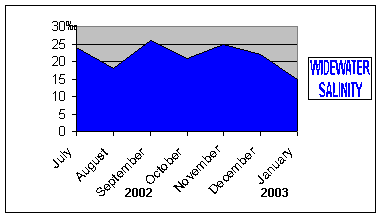
The morning
layer of snow
is so thin it could be mistaken for frost. The
precipitation of Shoreham beach up to 9:00
am was a mere 1.022 mm, with the temperature
at its lowest point at 1.7ºC at 7:50
am and a dew
point falling to -0.9ºC at 6:16 am.
Wind chill was -5.3ºC was 7:48 am
and although it is getting warmer, the wind chill in the Light Breeze (Force
2) was still below freezing in mid-morning. There
was no ice on garden ponds.
3 January
2003
Amongst
the scant remaining vegetation at a high spring tide, at least three pipits
perched and flew around just above the water surface south-west of the
Footbridge
over the Adur (TQ 216 047).
These were not the plump Meadow Pipits
of the local fields but a different bird altogether, thin and straggly
with a much paler speckled breasts with plenty of white, and a more marked
face with a bit of a dark top. The white, or was it grey, tail feathers
were not so bright either. So this bird was either a Rock
Pipit (Scandinavian Race) or a Water
Pipit, Anthus
spinoletta. They were not easily perturbed,
but they all flew off over the estuary before I could get my camera out.
It seems from research and consultation that the identity is most likely
to be a Water Pipit,
which is not what I thought of at first. (The full subspecies name of the
Rock
Pipit [Scandinavian
Race] is Anthus
petrosus littoralis.) These
pipits can be a bit tricky to identify.
Last
Meadow Pipit Report
Pipit
on Lancing Beach
Trouble
with Pipits Identification
Adur
Estuary Page
Anthus
petrosus littoralis (Sussex records)
Rock
Pipits Observation Page (BMLSS)
Rock
Pipits (Birdguides)
Water
Pipits
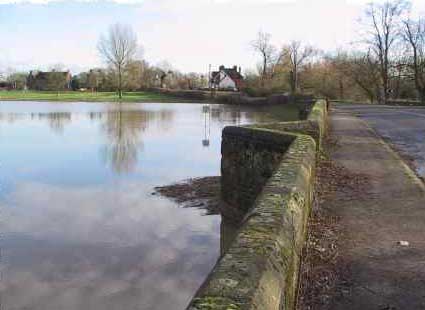
Floods
at Mock Bridge, River Adur
Photograph
by Allen
Pollard
My first
butterfly
of the year was almost certainly a Small
Tortoiseshell that fluttered out of the
Hawthorn
and
Dogwood scrub
on the south east corner of the dewpond field on Lancing
Clump.
UK
Butterfly Calendar
A
single Great Tit
was spotted before it darted into an Ivy laden Hawthorn.
Full
Report
Friends
of Lancing Ring
 2
January 2003 2
January 2003
On
a day noted for its dampness with mud and sodden ground, there was a remarkable
scarcity of birds and other wildlife in all the normal haunts. From a small
bush outside the entrance to Ricardo's (TQ
125 059) on the airport side of the Toll
Bridge at Old Shoreham, a Song Thrush
performed its repertoire of songs, filling the dusk air with melody. The
songs were heard again in various parts of Shoreham
town. Almost everywhere there were large gardens, or parks on any bushes
to sing from the Song Thrush
seemed to be singing. The wet winters of late seemed to have benefited
this bird that feeds mainly on worms, although in hard winters it is capable
of tackling snails when the frozen ground makes worms difficult to come
by.
1 January
2003
The
Long
tailed Tits,
Aegithalos caudatus,
are feeding on peanuts provided in my Shermanbury garden.
Upper
Adur East (Shermanbury area) Nature Pages
|


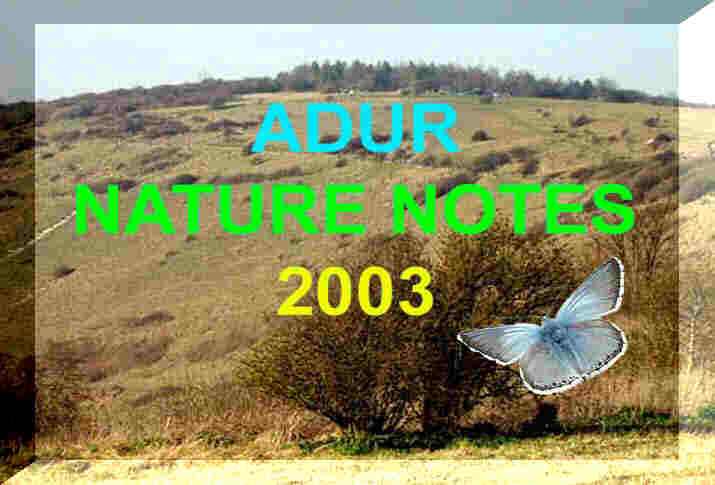

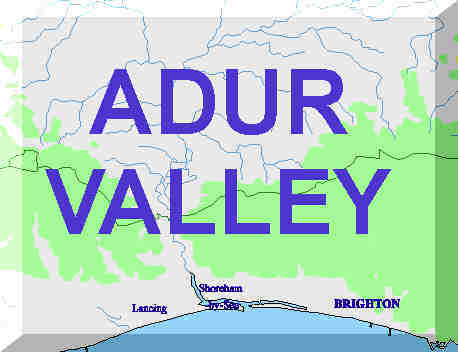

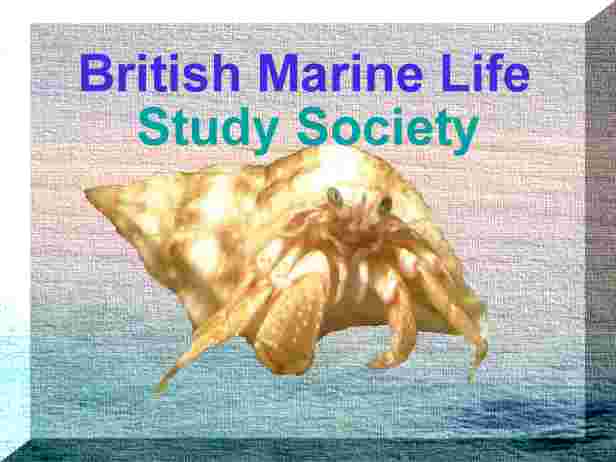
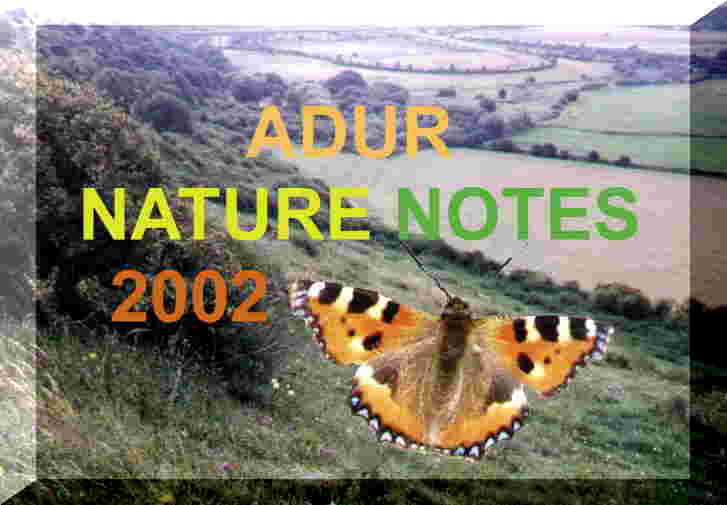



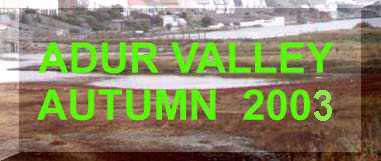










 At
high tide, there was just a small patch of mud covered in greenery (
At
high tide, there was just a small patch of mud covered in greenery (



